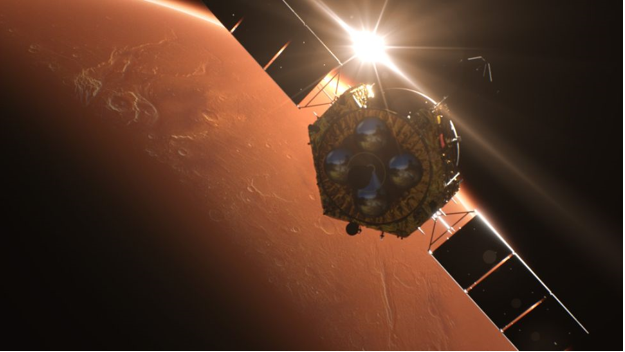China's Tianwen-1 Mars mission adjusts orbit to prepare for a Red Planet landing

An artist’s illustration of China’s Tianwen-1 mission in orbit around Mars. (Image credit: CNSA)
China’s Tianwen-1 spacecraft now orbiting Mars is slated to perform systematic checks of onboard equipment after adjusting its orbit in preparations for the country’s first Martian landing attempt later this year.
The Tianwen-1 orbiter used its 3,000-newton engine on Feb. 15 to place itself into a polar orbit around the Red Planet. Tipping the scales at 5 metric tons, Tianwen-1 — consisting of an orbiter, lander and rover — will perform several more orbital adjustments before placing itself into a parking orbit from which the orbiter will perform an initial survey of candidate landing areas.
Sometime in May or June, the Mars orbiter will be briefly placed in a deorbit and entry arc to release the landing capsule, replete with the as-yet-unnamed Tianwen-1 rover. The rover will egress from the lander onto the Martian surface a few days after touchdown, following an appraisal of the surrounding terrain.
For at least 92 Martian days (or about 95 Earth days), the rover will conduct high resolution, on-the-spot surveys of Mars.
The first mission of China’s deep exploration plan, Tianwen-1 will carry out a comprehensive study of Mars by orbiting, landing and roving on the Red Planet, conducting studies of Mars’ magnetosphere and ionosphere, and studying the planet’s surface and subsurface, according to Zou Yongliao, deputy director of the National Space Science Center at the Chinese Academy of Sciences in Beijing, who published a paper in the journal Advances in Space Research last month about Tianwen-1’s payloads and science objectives.
Scouting for subsurface water ice on Mars is the duty of Tianwen-1’s Mars Orbiter Subsurface Investigation Radar (MOSIR) — a subsurface radar sounder. MOSIR is intended to search for water ice and liquid water that may be associated with signs of life in the polar layered deposits, the Tianwen-1 lander/rover touchdown site and other selected areas.
The lander/rover machinery is expected to land on Mars in May or June. Chinese space engineers and scientists have selected candidate landing zones within the relatively flat region in the southern part of the Utopia Planitia, a large plain.
Uncertainty and risks
“When the probe brakes in the Martian atmosphere, it will face a process of high temperature, and deviation of attitude due to aerodynamics, which will have a negative impact on the deceleration,” said Tan Zhiyun, deputy chief designer of the Mars probe with the China Aerospace Science and Technology Corporation, told China Central Television (CCTV) in a recent interview. “Considering the unpredictability of the Martian atmosphere, there will be a lot of uncertainty and risks,” he added.
Next, the lander/rover entry vehicle deploys its parachute with its speed slowing to less than 100 meters per second (224 mph).
“The process will take about 80 to 100 seconds. When reaching 100 meters [328 feet] above the Mars surface, it will enter a hover stage,” Tan said. At that time, a microwave ranging and velocity sensor system is to make a measurement of the surface, he added, and a three-dimensional laser camera will take images of the surface of the landing area. The lander may perform translational motions at the 100-meter (328 feet) mark to assure the landing spot is safe.
